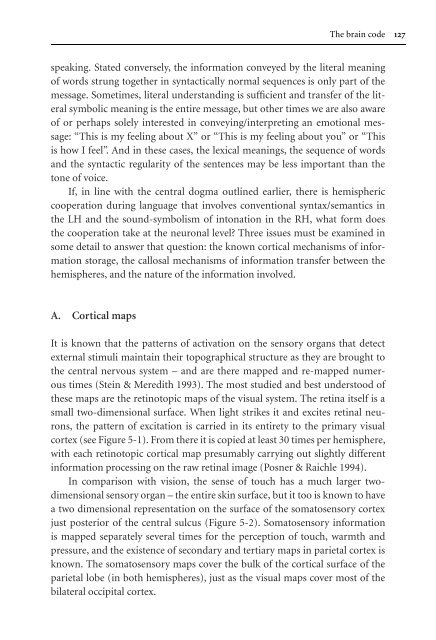Tone of Voice and Mind : The Connections between Intonation ...
Tone of Voice and Mind : The Connections between Intonation ...
Tone of Voice and Mind : The Connections between Intonation ...
Create successful ePaper yourself
Turn your PDF publications into a flip-book with our unique Google optimized e-Paper software.
<strong>The</strong> brain code 127<br />
speaking. Stated conversely, the information conveyed by the literal meaning<br />
<strong>of</strong> words strung together in syntactically normal sequences is only part <strong>of</strong> the<br />
message. Sometimes, literal underst<strong>and</strong>ing is sufficient <strong>and</strong> transfer <strong>of</strong> the literal<br />
symbolic meaning is the entire message, but other times we are also aware<br />
<strong>of</strong> or perhaps solely interested in conveying/interpreting an emotional message:<br />
“This is my feeling about X” or “This is my feeling about you” or “This<br />
is how I feel”. And in these cases, the lexical meanings, the sequence <strong>of</strong> words<br />
<strong>and</strong> the syntactic regularity <strong>of</strong> the sentences may be less important than the<br />
tone <strong>of</strong> voice.<br />
If, in line with the central dogma outlined earlier, there is hemispheric<br />
cooperation during language that involves conventional syntax/semantics in<br />
the LH <strong>and</strong> the sound-symbolism <strong>of</strong> intonation in the RH, what form does<br />
the cooperation take at the neuronal level? Three issues must be examined in<br />
some detail to answer that question: the known cortical mechanisms <strong>of</strong> information<br />
storage, the callosal mechanisms <strong>of</strong> information transfer <strong>between</strong> the<br />
hemispheres, <strong>and</strong> the nature <strong>of</strong> the information involved.<br />
A. Cortical maps<br />
It is known that the patterns <strong>of</strong> activation on the sensory organs that detect<br />
external stimuli maintain their topographical structure as they are brought to<br />
the central nervous system – <strong>and</strong> are there mapped <strong>and</strong> re-mapped numerous<br />
times (Stein & Meredith 1993). <strong>The</strong> most studied <strong>and</strong> best understood <strong>of</strong><br />
thesemapsaretheretinotopicmaps<strong>of</strong>thevisualsystem.<strong>The</strong>retinaitselfisa<br />
small two-dimensional surface. When light strikes it <strong>and</strong> excites retinal neurons,<br />
the pattern <strong>of</strong> excitation is carried in its entirety to the primary visual<br />
cortex (see Figure 5-1). From there it is copied at least 30 times per hemisphere,<br />
with each retinotopic cortical map presumably carrying out slightly different<br />
information processing on the raw retinal image (Posner & Raichle 1994).<br />
In comparison with vision, the sense <strong>of</strong> touch has a much larger twodimensional<br />
sensory organ – the entire skin surface, but it too is known to have<br />
a two dimensional representation on the surface <strong>of</strong> the somatosensory cortex<br />
just posterior <strong>of</strong> the central sulcus (Figure 5-2). Somatosensory information<br />
is mapped separately several times for the perception <strong>of</strong> touch, warmth <strong>and</strong><br />
pressure, <strong>and</strong> the existence <strong>of</strong> secondary <strong>and</strong> tertiary maps in parietal cortex is<br />
known. <strong>The</strong> somatosensory maps cover the bulk <strong>of</strong> the cortical surface <strong>of</strong> the<br />
parietal lobe (in both hemispheres), just as the visual maps cover most <strong>of</strong> the<br />
bilateral occipital cortex.


